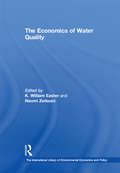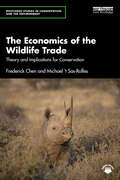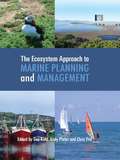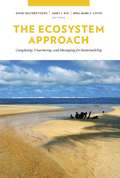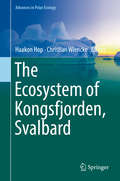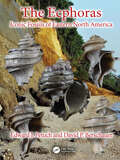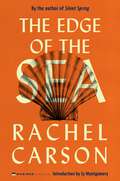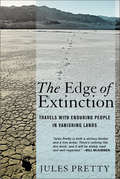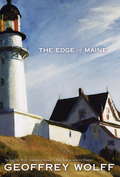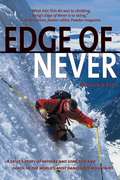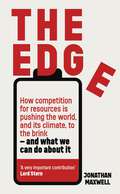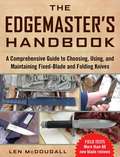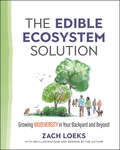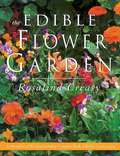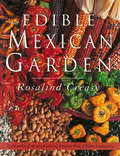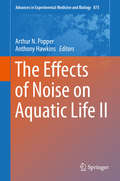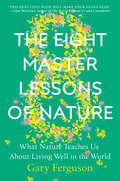- Table View
- List View
The Economics of Water Quality (The International Library of Environmental Economics and Policy)
by Naomi ZeitouniThis volume brings together a number of prominent economic studies all of which deal with key water quality issues. The studies focus on the economic aspects of water quality including identifying the polluters' actions and incentives, designing and comparing control mechanisms, analyzing the costs and benefits of water quality programmes, and finally managing transboundary water quality. They all make recommendations for improving water quality through changing incentives, programmes and/or policies.
The Economics of the Wildlife Trade: Theory and Implications for Conservation (Routledge Studies in Conservation and the Environment)
by Frederick Chen Michael ’t Sas-RolfesThis book presents a thorough overview and assessment of the economics of the wildlife trade for scholars and conservationists, requiring only a basic understanding of economic principles.Wildlife conservation and the sustainable extraction of living organisms from the wild for human use are fundamentally tied to issues of resource allocation and economics. Yet, there has been a conspicuous dearth of scholarly contribution that examines the wildlife trade using the theories and analytical tools provided by economists. This book fills this gap by presenting a theoretical framework built on a foundation of microeconomic theory that is used to analyze the trade in wildlife goods, the potential effects of various conservation policies, and the economic forces that govern the workings of the markets for wildlife goods. The focus of the book is on explicating the possible impacts of supply-side policies that have been implemented or proposed to achieve a sustainable level of wildlife extraction. The policies that will be considered include the following: stricter anti-poaching policies; trade bans; and legalizing the sale of alternative sources of supplies such as farmed goods, synthetic substitutes, and accumulated stockpiles. The book discusses how the implementation of these policies could affect the incentives of both the suppliers and buyers of wildlife goods to participate in these markets. It also considers how market structure, market concentration, and asymmetric information can affect the impact of these policies.This book is intended for scholars, practitioners, and policymakers in the field of wildlife conservation who are familiar with basic economics and interested in a rigorous exposition of the economic principles relevant to the study of the wildlife trade.
The Ecopoetry Anthology
by Robert Hass Laura-Gray Street Ann Fisher-WirthDefinitive and daring, The Ecopoetry Anthology is the authoritative collection of contemporary American poetry about nature and the environment--in all its glory and challenge. From praise to lament, the work covers the range of human response to an increasingly complex and often disturbing natural world and inquires of our human place in a vastness beyond the human.To establish the antecedents of today's writing,The Ecopoetry Anthology presents a historical section that includes poetry written from roughly the mid-nineteenth to the mid-twentieth century. Iconic American poets like Walt Whitman and Emily Dickinson are followed by more modern poets like Wallace Stevens, William Carlos Williams, Ezra Pound, and even more recent foundational work by poets like Theodore Roethke, Elizabeth Bishop, Robert Hayden, and Muriel Rukeyser. With subtle discernment, the editors portray our country's rich heritage and dramatic range of writing about the natural world around us.
The Ecosystem Approach to Marine Planning and Management (Earthscan Oceans)
by Sue Kidd Andy Plater Chris FridThe marine environment is one of our most precious yet fragile natural resources. It provides a wide range of essential goods and services, including food, regulation of climate and nutrient cycling, as well as a setting for transport, recreation and tourism. This environment is however extremely complex and very sensitive to development pressures and other forms of human influence. Planning and management of the sea are similarly complicated, reflecting intricate legal, institutional and ownerships patterns. This creates a situation where marine ecosystems are vulnerable to over-exploitation or neglect. The Ecosystem Approach to Marine Planning and Management describes how growing concern about the state of our seas is resulting in the development of new approaches to marine planning and management. For example, the United Nations Environment Programme has called for the widespread introduction of Marine Spatial Planning (MSP), and the European Union has recently been consulting on a new European Maritime Policy designed to stimulate economic growth but at the same time protect the resource base. Within the United Kingdom, the 2010 Marine Act draws upon the experience of town and country planning and brings into being a new system of Marine Spatial Planning. The authors show that a common feature of all these developments is an appreciation that more integrated forms of planning and management are required for our seas and that new arrangements must draw together understanding from natural science, social science and many other perspectives. Adopting such a trans-disciplinary and holistic (or 'ecosystems') approach, the book distils the expertise of these different disciplines and seeks to promote a broader understanding of the origins and practicalities of new approaches to marine planning and management.
The Ecosystem Approach: Complexity, Uncertainty, and Managing for Sustainability
by David Waltner-Toews James J. Kay Nina-Marie E. ListerIs sustainable development a workable solution for today's environmental problems? Is it scientifically defensible? Best known for applying ecological theory to the engineering problems of everyday life, the late scholar James J. Kay was a leader in the study of social and ecological complexity and the thermodynamics of ecosystems. Drawing from his immensely important work, as well as the research of his students and colleagues, The Ecosystem Approach is a guide to the aspects of complex systems theories relevant to social-ecological management. Advancing a methodology that is rooted in good theory and practice, this book features case studies conducted in the Arctic and Africa, in Canada and Kathmandu, and in the Peruvian Amazon, Chesapeake Bay, and Chennai, India. Applying a systems approach to concrete environmental issues, this volume is geared toward scientists, engineers, and sustainable development scholars and practitioners who are attuned to the ideas of the Resilience Alliance-an international group of scientists who take a more holistic view of ecology and environmental problem-solving. Chapters cover the origins and rebirth of the ecosystem approach in ecology; the bridging of science and values; the challenge of governance in complex systems; systemic and participatory approaches to management; and the place for cultural diversity in the quest for global sustainability.
The Ecosystem of Kongsfjorden, Svalbard (Advances in Polar Ecology #2)
by Christian Wiencke Haakon HopThis book focuses in detail on all ecologically important aspects of the Kongsfjorden system such as the marine and atmospheric environment including long-term monitoring, Ecophysiology of individual species, structure and function of the ecosystem, ecological processes and biological communities.The contributed articles include review articles and research articles that have a wider approach and bring the current research up-to-date. This book will form a baseline for future work.
The Ecosystems Revolution
by Mark EverardThis book explores humanity's relationship with the natural world throughout evolutionary history, and the need to reorient this onto a symbiotic basis. It integrates the themes of natural and artificial selection, the characteristics of historic 'revolutions', and directed versus random change. Inspiring community-based projects, mainly from the developing world, show how ecosystem regeneration uplifts human livelihoods in a positively reinforcing cycle, embodying lessons germane to co-creating a Symbiocene era wherein humanity's substantial influence (the Anthropocene) achieves increasing symbiosis with the natural processes shaping the former Holocene epoch. The Ecosystems Revolution provides practical, positive examples, highlighting the attainability of an 'ecosystems revolution'.
The Ecphoras: Iconic Fossils of Eastern North America
by Edward J. Petuch David P. BerschauerIn the Miocene and Pliocene fossil shell beds of the eastern United States, the single most spectacular molluscan species radiation is seen in the ecphora shells (the Tribe Ecphorini). These bizarrely shaped gastropods, with their distinctive ribbed shell sculpture, represent a separate branch of the Subfamily Ocenebridae, Family Muricidae. Characteristically, these muricid gastropods are heavily ornamented with spiral ribs and cords and are considered some of the most beautiful and interesting groups of fossil mollusks found along the Atlantic Coastal Plain and Floridian Peninsula. The ecphoras are greatly sought after by fossil collectors. The ecphora faunas, and their individual species and subspecies, are illustrated and described in detail, along with photographs of ecphora-bearing geological units and in-situ specimens. The authors list the 67 known species and subspecies that are recognized as valid, arranged by the eight genera and five subgenera that encompass these taxa.
The Edge Of The Sea: Under The Sea-wind / The Sea Around Us / The Edge Of The Sea
by Rachel CarsonWith all the hallmarks of Rachel Carson's luminous prose combined with a scientifically accurate exploration of the Atlantic seashore comes a hauntingly beautiful account of what one can find at the edge of the sea. "The edge of the sea is a strange and beautiful place." Focusing on the plants and invertebrates surviving in the Atlantic zones between the lowest and the highest tides, between Newfoundland and the Florida Keys, The Edge of the Sea is a book to be read for pleasure as well as a practical identification guide. Its appendix and index make it a great reference tool for those interested in plant and animal life around tidepools. A new generation of readers is already discovering why Rachel Carson's books have become cornerstones of the environmental and conservation movements. With an Introduction by Sue Hubbell.
The Edge of Extinction: Travels with Enduring People in Vanishing Lands
by Jules PrettyIn The Edge of Extinction, Jules Pretty explores life and change in a dozen environments and cultures across the world, taking us on a series of remarkable journeys through deserts, coasts, mountains, steppes, snowscapes, marshes, and farms to show that there are many different ways to live in cooperation with nature. From these accounts of people living close to the land and close to the edge emerge a larger story about sustainability and the future of the planet. Pretty addresses not only current threats to natural and cultural diversity but also the unsustainability of modern lifestyles typical of industrialized countries. In a very real sense, Pretty discovers, what we manage to preserve now may well save us later. Jules Pretty's travels take him among the Maori people along the coasts of the Pacific, into the mountains of China, and across petroglyph-rich deserts of Australia. He treks with nomads over the continent-wide steppes of Tuva in southern Siberia, walks and boats in the wildlife-rich inland swamps of southern Africa, and experiences the Arctic with ice fishermen in Finland. He explores the coasts and inland marshes of eastern England and Northern Ireland and accompanies Innu people across the taiga’s snowy forests and the lakes of the Labrador interior. Pretty concludes his global journey immersed in the discrete cultures and landscapes embedded within the American landscape: the small farms of the Amish, the swamps of the Cajuns in the deep South, and the deserts of California. The diverse people Pretty meets in The Edge of Extinction display deep pride in their relationships with the land and are only willing to join with the modern world on their own terms. By the examples they set, they offer valuable lessons for anyone seeking to find harmony in a world cracking under the pressures of apparently insatiable consumption patterns of the affluent.
The Edge of Maine
by Geoffrey WolffNow, with the voice of a passionate insider, he brings readers into the heart of this striking region and explains what makes it unique. Starting with a gripping tale about being lost offshore in the fog with inadequate navigational aids, Wolff goes on to describe the coast's geological history and discovery by Europeans. He then turns a keen eye towards Mainers, their mores and peculiarities, and to the summer rusticators who for generations have invaded the stunning waterfronts. A section on boat building celebrates the extraordinary rescue of Maine's foremost craft; another on lobsters tells the rich story of the custom, taste, commerce, environmental conflict, and scientific mystery surrounding these critical crustaceans. Here is a true feast--travel literature at its best.
The Edge of Never: A Skier's Story of Life, Death, and Dreams in the World's Most Dangerous Mountains
by William A. KerigIn the world of big-mountain skiing, Trevor Petersen was a legend. Appearing in countless films, magazines and photo shoots, his ponytail flying behind him, he was the very embodiment of the freewheeling spirit of extreme skiing in the 1980s and early '90s. Then it all came to an end. On February 26, 1996, while skiing in Chamonix, France - the so-called Death Sport Capital of the World - an avalanche swept Trevor away. His body was found sitting up in the snow as if gazing at the mountains he loved. Nearly a decade later, Trevor's fifteen-year-old son, Kye Petersen, a rising star in his own right, traveled to Chamonix to ski the run that took his father's life and, with the aid of some of the world's greatest ski mountaineers, to become a member of skiing's big-mountain tribe. There to chronicle Kye's story was William A. Kerig, a filmmaker with a dream of his own - to create a film about the soul of big-mountain skiing and the band of mountaineers who ski the steepest, wildest, most dangerous terrain in the world. In The Edge of Never, Kerig gives us not only a ripping adventure tale about a young man coming of age but a frank and subtle portrait of the extreme skiers who "live big" in the face of death and risk everything to experience the fullness of life in the mountains.
The Edge: How competition for resources is pushing the world, and its climate, to the brink – and what we can do about it.
by Jonathan MaxwellWe live in a World which, though the origins are long, seems suddenly transformed by economic events way out of our control. In seeking stability, we must acknowledge the seismic scale of the challenge, and understand the devastating impact of global energy inefficiency. Every society, organisation, business, household and individual must put efficiency first - not just to save money and carbon and improve resilience, but to reduce the risk, or effect, of conflict.THE EDGE is a very contemporary look at how the world has been transformed by recent economic events, focusing on climate change, the war in Ukraine, the Chinese economy and the challenges the world faces around inflation, energy, transport, fuel, imports etc. Written from an economist/investor's perspective, with lessons for pretty much every institution challenged by these developments, it is a timely and essential resource authored by a global expert with peerless connections, from major organisations to government insiders, from investors to energy corporations. It will help businesses and economies currently at the mercy of the markets to transition towards sustainability, productivity and prosperity, and help everyone understand the world in 2023.
The Edgemaster's Handbook: A Comprehensive Guide to Choosing, Using, and Maintaining Fixed-Blade and Folding Knives
by Len McDougallDo you feel a soul-deep connection with knives and tools that are engineered to cut through other materials? Does having a sturdy knife on your person imbue you with a profound, but somehow unidentifiable, sense of security? The Edgemaster’s Handbook is just that: a book completely dedicated to the care and usage of knives. Whether handling a dagger, stiletto, or bolo, you’ll learn the knife’s purpose and how to use is properly while keeping the blade clean and yourself safe. Len McDougall has spent his entire life—almost sixty years—learning the nuts and bolts of staying alive under adverse conditions and the mastery of weapons. And now more than ever we will need to take his lessons seriously, as understanding what to expect and how to adapt will increase the odds for survival. Featuring methods that have been personally tested through hard, field-proven experiences, you will learn everything needed to use knives for both outdoor living and protection. Included in this book are many lessons on knives, including: Sharpening a blade How to properly identify different types Collecting Using for survival and self-defense And so much more Whether for the collector or the outdoorsman, McDougall shares all his knowledge and understanding of this tool for you to understand and better appreciate. The Edgemaster’s Handbook is just that; a collection of tips, tricks, lessons, and knowledge from a professional that will make sure you master the usage of knives in your daily life.
The Edible Ecosystem Solution: Growing Biodiversity in Your Backyard and Beyond
by Zach LoeksStart a peaceful revolution by planting an edible ecosystem and sharing the experience with your neighborsHumans have always thrived in rich, diverse, edible ecosystems. Yet most cities and suburbs are blanketed by lawns, ornamentals, and a lack of biodiversity, let alone anything edible. It is within these sterile landscapes that seeds of an edible ecosystem lie.The Edible Ecosystem Solution is a comprehensive, practical guidebook that looks at underutilized spaces to reveal the many opportunities for landscape transformation that are both far-reaching and immediately beneficial and enjoyable. Contents include:Hundreds of full-color infographics, illustrations, and photographs that clearly outline the principles and concepts of edible landscape design and benefitsHow to get started with as little as 25 square feet of landHow to transition a garden plot into a place of edible abundance and an edible biodiversity hot spot, living laboratory, and a source point for transitioning and transforming community and cultureChoosing appropriate plants for insects, wildlife, and food productionScaling up and networking backyard edible ecosystems at the neighborhood level and beyond to build community food security and resilience.The Edible Ecosystem Solution is for everyone with access to a bit of yard, a desire for food security, biodiversity, and a beautiful and resilient community, and for anyone who wants to reclaim humanity's place in a rich, abundant, edible ecosystem.
The Edible Flower Garden
by Rosalind CreasyA comprehensive guide to selecting and growing flowers that can be used for cookery, both as garnishes and as ingredients.
The Edible Flower Garden
by Rosalind CreasyThe Edible Flower Garden is a beautiful collection of flowers that can be used for cookery: from candied violets and roses to decorate appetizers and cakes, to nasturtiums for a colorful shrimp salad, to day lily buds, pink clover, and wild mustard flowers that are tossed together in a spectacular stir-fry.
The Edible Front Yard: The Mow-Less, Grow-More Plan for a Beautiful, Bountiful Garden
by Ivette Soler“Front lawns, beware: The Germinatrix has you in her crosshairs! Ivette Soler is a welcome voice urging us to mow less and grow some food—in her uniquely fun, infectious yet informative way.” —Garden RantPeople everywhere are turning patches of soil into bountiful vegetable gardens, and each spring a new crop of beginners pick up trowels and plant seeds for the first time. They're planting tomatoes in raised beds, runner beans in small plots, and strawberries in containers. But there is one place that has, until now, been woefully neglected—the front yard. And there's good reason. The typical veggie garden, with its raised beds and plots, is not the most attractive type of garden, and favorite edible plants like tomatoes and cucumbers have a tendency to look a scraggily, even in their prime. But The Edible Front Yard isn't about the typical veggie garden, and author Ivette Soler is passionate about putting edibles up front and creating edible gardens with curb appeal. Soler offers step-by-step instructions for converting all or part of a lawn into an edible paradise; specific guidelines for selecting and planting the most attractive edible plants; and design advice and plans for the best placement and for combining edibles with ornamentals in pleasing ways. Inspiring and accessible, The Edible Front Yard is a one-stop resource for a front-and-center edible garden that is both beautiful and bountiful year-round.
The Edible Mexican Garden
by Rosalind CreasyWith gorgeous, four-color photographs, and simple yet authoritative text, award-winning author Rosalind Creasy offers four new volumes in her popular Edible Garden series, each featuring helpful hints, expert gardening techniques, delicious recipes, and interviews with master gardeners and renowned chefs. The most unassuming of garden vegetables from your garden- corn, beans, peppers, greens, and onions- are transformed into traditional and contemporary Mexican dishes and delicacies to awaken the palate and entice the eye.
The Edwardian Gardener's Guide
by Twigs WayIt is Edwardian England, and a delightful flower garden and fruitful allotment are matters of personal pride, boons for the dinner table, and even 'important acts of local patriotism'. The Edwardian Gardener's Guide selects nuggets of wisdom from the best-selling One & All garden books, originally published in 1913. In these short booklets, the foremost agricultural and horticultural writers of the period revealed fashions in gardening styles, the best seasonal plants, how to enhance food production and now best to lay out adventurous rockeries, ferneries and grottoes. Packed with charming contemporary advertisements and color illustrations, this handbook gives a glimpse of the pre-First World War 'golden era' of British gardening. With an introduction by garden historian, Twigs Way.
The Effects of Noise on Aquatic Life II
by Arthur N. Popper Anthony HawkinsThe meeting of Aquatic Noise 2013 will introduce participants to the most recent research data, regulatory issues and thinking about effects of man-made noise and will foster critical cross-disciplinary discussion between the participants. Emphasis will be on the cross-fertilization of ideas and findings across species and noise sources. As with its predecessor, The Effects of Noise on Aquatic Life: 3rd International Conference will encourage discussion of the impact of underwater sound, its regulation and mitigation of its effects. With over 100 contributions from leading researchers, a wide range of sources of underwater sound will be considered.
The Eiger Obsession: Facing the Mountain That Killed My Father
by John Harlin IIIIn the 1960s an American named John Harlin II changed the face of Alpine climbing. Gutsy and gorgeous - he was known as 'the blond god' - Harlin successfully summitted some of the most treacherous mountains in Europe. But it was the North Face of the Eiger that became Harlin's obsession. Living with his wife and two children in Leysin, Switzerland, he spent countless hours planning to climb, waiting to climb, and attempting to climb the massive vertical face. It was the Eiger direct - the direttissima - with which John Harlin was particularly obsessed. He wanted to be the first to complete it, and everyone in the Alpine world knew it. John Harlin III was nine years old when his father made another attempt on a direct ascent of the notorious Eiger. Harlin had put together a terrific team and, despite unending storms, he was poised for the summit dash. It was the moment he had long waited for. When Harlin's rope broke, 2,000 feet from the summit, he plummeted 4,000 feet to his death. In the shadow of tragedy, young John Harlin III came of age possessed with the very same passion for risk that drove his father. But he had also promised his mother, a beautiful and brilliant young widow, that he would not be an Alpine climber. Harlin moved from Europe to America, and, with an insatiable sense of wanderlust, he revelled in downhill skiing and rock-climbing. For years he successfully denied the siren call of the mountain that killed his father. But in 2005, John Harlin could resist no longer. With his nine-year-old daughter, Siena - his very age at the time of his father's death - and with an IMAX Theatre filmmaking crew watching, Harlin set off towards the Eiger.
The Eight Master Lessons of Nature: What Nature Teaches Us About Living Well in the World
by Gary FergusonA riveting manifesto for the millions of people who long to forge a more vital, meaningful connection to the natural world to live a better, more fulfilling life Looking around at the world today—a world of skyscrapers, super highways, melting ice caps, and rampant deforestation—it is easy to feel that humanity has actively severed its ties with nature. It’s no wonder that we are starving to rediscover a connection with the natural world. With new insights into the inner workings of nature's wonders, Gary Ferguson presents a fascinating exploration into how many of the most remarkable aspects of nature are hardwired into our very DNA. What emerges is a dazzling web of connections that holds powerful clues about how to better navigate our daily lives. Through cutting-edge data and research, drawing on science, psychology, history, and philosophy, The Eight Master Lessons of Nature will leave readers with a feeling of hope, excitement, and joy. It is a dazzling statement about the powers of physical, mental, and spiritual wellness that come from reclaiming our relationship with Mother Nature. Lessons about mystery, loss, the fine art of rising again, how animals make us smarter, and how the planet’s elders make us better at life are unforgettable and transformative.
The El Niño-Southern Oscillation Phenomenon
by Edward S. Sarachik Mark A. CaneMany climatic extremes around the globe, such as severe droughts and floods, can be attributed to the periodic warming of the equatorial Pacific sea surface, termed the El Ni#xF1;o or Southern Oscillation (ENSO). Advances in our understanding of ENSO, in which Edward Sarachik and Mark Cane have been key participants, have led to marked improvements in our ability to predict its development months or seasons, allowing adaptation to global impacts. The book introduces basic concepts and builds to more detailed theoretical treatments. Chapters on the structure and dynamics of the tropical ocean and atmosphere place ENSO in a broader observational and theoretical context. Chapters on ENSO prediction, past and future, and impacts introduce broader implications of the phenomenon. This book provides an introduction to all aspects of this most important mode of global climate variability, for research workers and students of all levels in climate science, oceanography and related fields.
